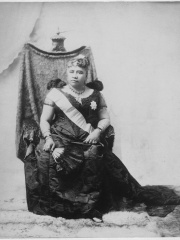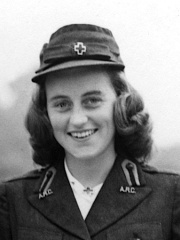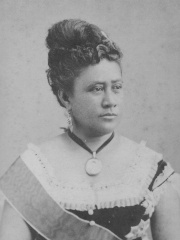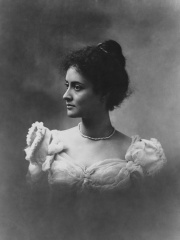







The Most Famous
NOBLEMEN from United States
This page contains a list of the greatest American Noblemen. The pantheon dataset contains 1,415 Noblemen, 10 of which were born in United States. This makes United States the birth place of the 19th most number of Noblemen behind Egypt, and Monaco.
Top 10
The following people are considered by Pantheon to be the top 10 most legendary American Noblemen of all time. This list of famous American Noblemen is sorted by HPI (Historical Popularity Index), a metric that aggregates information on a biography's online popularity. Visit the rankings page to view the entire list of American Noblemen.

1. Liliʻuokalani (1838 - 1917)
With an HPI of 79.39, Liliʻuokalani is the most famous American Nobleman. Her biography has been translated into 62 different languages on wikipedia.
Liliʻuokalani (Hawaiian pronunciation: [liˌliʔuokəˈlɐni]; Lydia Liliʻu Loloku Walania Kamakaʻeha; September 2, 1838 – November 11, 1917) was the only queen regnant and the last sovereign monarch of the Hawaiian Kingdom, ruling from January 29, 1891, until the overthrow of the Hawaiian Kingdom on January 17, 1893, in a coup that was led by the Committee of Safety, composed of seven foreign residents (five Americans, one Scotsman, and one German) and six Hawaiian Kingdom subjects of American descent in Honolulu. The composer of "Aloha ʻOe" and numerous other works, she wrote her autobiography Hawaiʻi's Story by Hawaiʻi's Queen (1898) during her imprisonment following the overthrow. Liliʻuokalani was born in 1838 in Honolulu, on the island of Oʻahu. While her natural parents were Analea Keohokālole and Caesar Kapaʻakea, she was hānai (informally adopted) at birth by Abner Pākī and Laura Kōnia and raised with their daughter Bernice Pauahi Bishop. Baptized as a Christian and educated at the Royal School, she and her siblings and cousins were proclaimed eligible for the throne by King Kamehameha III. She was married to American-born John Owen Dominis, who later became the Governor of Oʻahu. The couple had no biological children but adopted several. After the accession of her brother David Kalākaua to the throne in 1874, she and her siblings were given Western-style titles of Prince and Princess. In 1877, after her younger brother Leleiohoku II's death, she was proclaimed as heir apparent to the throne. During the Golden Jubilee of Queen Victoria, she represented her brother as an official envoy to the United Kingdom. Liliʻuokalani ascended to the throne on January 29, 1891, nine days after her brother's death. During her reign, she attempted to draft a new constitution which would restore the power of the monarchy and the voting rights of the economically disenfranchised. Threatened by her attempts to abrogate the Bayonet Constitution, pro-American elements in Hawaiʻi overthrew the monarchy on January 17, 1893. The overthrow was bolstered by the landing of US Marines under John L. Stevens to protect American interests, which rendered the monarchy unable to protect itself. The coup d'état established a Provisional Government which became the Republic of Hawaiʻi, but the ultimate goal was the annexation of the islands to the United States, which was temporarily blocked by President Grover Cleveland. After an unsuccessful uprising to restore the monarchy, the oligarchical government placed the former queen under house arrest at the ʻIolani Palace. On January 24, 1895, under threat of execution of her imprisoned supporters, Liliʻuokalani was forced to abdicate the Hawaiian throne, officially resigning as head of the deposed monarchy. Attempts were made to restore the monarchy and oppose annexation, but with the outbreak of the Spanish–American War, the United States annexed Hawaiʻi. Living out the remainder of her later life as a private citizen, Liliʻuokalani died at her residence, Washington Place, in Honolulu in 1917.

2. Kathleen Cavendish, Marchioness of Hartington (1920 - 1948)
With an HPI of 67.80, Kathleen Cavendish, Marchioness of Hartington is the 2nd most famous American Nobleman. Her biography has been translated into 17 different languages.
Kathleen Agnes Cavendish, Marchioness of Hartington (née Kennedy; February 20, 1920 – May 13, 1948), also known as "Kick" Kennedy, was an American socialite. She was the second daughter of Joseph P. Kennedy Sr. and Rose Fitzgerald, a sister of U.S. President John F. Kennedy and Senators Robert F. Kennedy and Ted Kennedy, and the wife of the Marquess of Hartington, heir apparent to the 10th Duke of Devonshire. When her father was serving as U.S. Ambassador to the United Kingdom, Kathleen made many friends in London and was the "debutante of 1938". Working with the Red Cross, she began a romantic relationship with Lord Hartington, whom she married in May 1944. He was killed on active service in Belgium only four months later. Kathleen died in a plane crash in 1948, flying to the south of France while on vacation with her new partner, the 8th Earl Fitzwilliam.

3. Queen Noor of Jordan (b. 1951)
With an HPI of 67.08, Queen Noor of Jordan is the 3rd most famous American Nobleman. Her biography has been translated into 42 different languages.
Noor Al Hussein (Arabic: نور الحسين; born Lisa Najeeb Halaby; August 23, 1951) is an American-born Jordanian philanthropist and activist who was the fourth wife and widow of King Hussein of Jordan. She was Queen of Jordan from their marriage on June 15, 1978, until Hussein's death on February 7, 1999. Noor is the longest-standing member of the Board of Commissioners of the International Commission on Missing Persons. As of 2023, she is president of the United World Colleges movement and an advocate of the anti-nuclear weapons proliferation campaign Global Zero. In 2015, Queen Noor received Princeton University's Woodrow Wilson Award for her public service.

4. John Paul Getty III (1956 - 2011)
With an HPI of 58.54, John Paul Getty III is the 4th most famous American Nobleman. His biography has been translated into 18 different languages.
John Paul Getty III (; born Eugene Paul Getty II; November 4, 1956 – February 5, 2011) was the grandson of the American-born British oil tycoon J. Paul Getty, who was once the richest man in the world. While living in Rome in 1973, he was kidnapped by the 'Ndrangheta, an Italian criminal organization based in Calabria, and held for a $17 million ransom. His grandfather initially refused to pay, but, after John Paul Getty III's severed ear was received by a newspaper, his grandfather relented to a new, lower demand, and Getty was released five months after being kidnapped. Getty subsequently developed an addiction to alcohol and other drugs, leading to an overdose and stroke in 1981 at the age of 25, which left him severely disabled for the rest of his life.

5. Kaʻiulani (1875 - 1899)
With an HPI of 53.90, Kaʻiulani is the 5th most famous American Nobleman. Her biography has been translated into 17 different languages.
Princess Kaʻiulani (Hawaiian pronunciation: [kəʔiu'lɐni]; Victoria Kawēkiu Kaʻiulani Lunalilo Kalaninuiahilapalapa Cleghorn; October 16, 1875 – March 6, 1899) was a Hawaiian royal, the only child of Princess Miriam Likelike, and the last heir apparent to the throne of the Hawaiian Kingdom. She was the niece of King Kalākaua and Queen Liliʻuokalani. After the death of her mother, Kaʻiulani was sent to Europe at age 13 to complete her education under the guardianship of British businessman and Hawaiian sugar investor Theo H. Davies. She had not yet reached her eighteenth birthday when the 1893 overthrow of the Hawaiian Kingdom altered her life. The Committee of Safety rejected proposals from both her father Archibald Scott Cleghorn, and provisional president Sanford B. Dole, to seat Kaʻiulani on the throne, conditional upon the abdication of Liliʻuokalani. The Queen thought the Kingdom's best chance at justice was to relinquish her power temporarily to the United States. Davies and Kaʻiulani visited the United States to urge the Kingdom's restoration; she made speeches and public appearances denouncing the overthrow of her government and the injustice toward her people. While in Washington, D.C. she paid an informal visit to President Grover Cleveland and First Lady Frances Cleveland, but her efforts were in vain. The situation put both Kaʻiulani and her father in dire financial straits. Her annual government stipend ceased, and her father's income as a government employee came to an end. Father and daughter spent the years 1893–1897 drifting among the European aristocracy, relatives and family friends in England, Wales, Scotland and Paris, before finally returning to Hawaii. After arriving back in Hawaii in 1897, Kaʻiulani settled into life as a private citizen and busied herself with social engagements. She and Liliʻuokalani boycotted the 1898 annexation ceremony and mourned the loss of Hawaiian independence. However, she later hosted the American congressional delegation in charge of formalizing the Hawaiian Organic Act. She suffered from chronic health problems throughout the 1890s and died at her home at ʻĀinahau in 1899.

6. Kapiʻolani (1834 - 1899)
With an HPI of 49.45, Kapiʻolani is the 6th most famous American Nobleman. Her biography has been translated into 16 different languages.
Kapiʻolani (December 31, 1834 – June 24, 1899) was the queen of the Kingdom of Hawaiʻi as the consort of Mōʻī (king) Kalākaua, who reigned from 1874 until his death in 1891, when she became known as the Dowager Queen Kapiʻolani. Deeply interested in the health and welfare of Native Hawaiians, Kapiʻolani established the Kapiʻolani Home for Girls, for the education of the daughters of residents of the Kalaupapa Leprosy Settlement, and the Kapiʻolani Maternity Home, where Hawaiian mothers and newborns could receive care.

7. Philip, Hereditary Prince of Yugoslavia (b. 1982)
With an HPI of 46.27, Philip, Hereditary Prince of Yugoslavia is the 7th most famous American Nobleman. His biography has been translated into 16 different languages.
Filip Karađorđević (Serbian Cyrillic: Филип Карађорђевић; born 15 January 1982), sometimes referred to in English as Prince Philip Karageorgevitch and unofficially titled Philip, Hereditary Prince of Serbia and Yugoslavia (Serbian Cyrillic: Филип, принц наследник од Србије и Југославије, Filip, princ naslednik od Srbije i Jugoslavije), is a Serbian business manager, a member of the House of Karađorđević, and heir apparent to Crown Prince Alexander. He is the second grandson of the last King of Yugoslavia, Peter II. Born in the United States and raised in the United Kingdom, he was shaped into a finance and asset manager. In 2020, he moved to his homeland Serbia and took a more active role in public life, often travelling across Serbia, Kosovo, Montenegro, and Bosnia. His son is the first male child born to the Karađorđević royal family on Serbian soil for 90 years. In 2022, he became the hereditary prince, following his elder brother's renunciation.

8. Lilibet Mountbatten-Windsor (b. 2021)
With an HPI of 45.98, Lilibet Mountbatten-Windsor is the 8th most famous American Nobleman. Her biography has been translated into 39 different languages.
Princess Lilibet of Sussex (Lilibet Diana Mountbatten-Windsor; born 4 June 2021) is an American-born member of the British royal family. She is the daughter of Prince Harry, Duke of Sussex, and Meghan, Duchess of Sussex. She is a granddaughter of King Charles III and is seventh in the line of succession to the British throne.

9. Prince Constantine Alexios of Greece and Denmark (b. 1998)
With an HPI of 44.42, Prince Constantine Alexios of Greece and Denmark is the 9th most famous American Nobleman. His biography has been translated into 18 different languages.
Prince Constantine-Alexios of Greece and Denmark (Greek: Κωνσταντίνος Αλέξιος Ντε Γκρες, romanized: Konstantínos-Aléxios de Grèce; born 29 October 1998) is a Greek painter, sculptor, and member of the former Greek royal family. He is the eldest son and second child of Crown Prince Pavlos and Crown Princess Marie-Chantal of Greece.

10. Princess Leonore, Duchess of Gotland (b. 2014)
With an HPI of 43.37, Princess Leonore, Duchess of Gotland is the 10th most famous American Nobleman. Her biography has been translated into 30 different languages.
People
Pantheon has 10 people classified as American noblemen born between 1834 and 2021. Of these 10, 5 (50.00%) of them are still alive today. The most famous living American noblemen include Queen Noor of Jordan, Philip, Hereditary Prince of Yugoslavia, and Lilibet Mountbatten-Windsor. The most famous deceased American noblemen include Liliʻuokalani, Kathleen Cavendish, Marchioness of Hartington, and John Paul Getty III. As of April 2024, 2 new American noblemen have been added to Pantheon including Philip, Hereditary Prince of Yugoslavia, and Princess Leonore, Duchess of Gotland.
Living American Noblemen
Go to all RankingsQueen Noor of Jordan
1951 - Present
HPI: 67.08
Philip, Hereditary Prince of Yugoslavia
1982 - Present
HPI: 46.27
Lilibet Mountbatten-Windsor
2021 - Present
HPI: 45.98
Prince Constantine Alexios of Greece and Denmark
1998 - Present
HPI: 44.42
Princess Leonore, Duchess of Gotland
2014 - Present
HPI: 43.37
Deceased American Noblemen
Go to all RankingsLiliʻuokalani
1838 - 1917
HPI: 79.39
Kathleen Cavendish, Marchioness of Hartington
1920 - 1948
HPI: 67.80
John Paul Getty III
1956 - 2011
HPI: 58.54
Kaʻiulani
1875 - 1899
HPI: 53.90
Kapiʻolani
1834 - 1899
HPI: 49.45
Newly Added American Noblemen (2025)
Go to all RankingsPhilip, Hereditary Prince of Yugoslavia
1982 - Present
HPI: 46.27
Princess Leonore, Duchess of Gotland
2014 - Present
HPI: 43.37
Overlapping Lives
Which Noblemen were alive at the same time? This visualization shows the lifespans of the 5 most globally memorable Noblemen since 1700.

